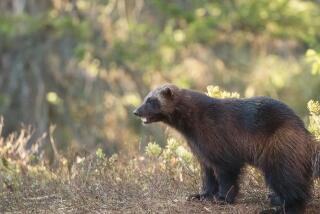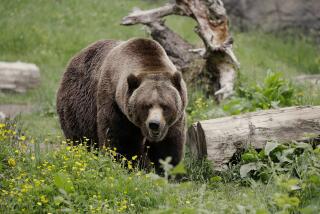U.S. Decides to Reintroduce Gray Wolves to Rockies : Conservation: Animals will run wild in Yellowstone and other wilderness areas. Some ranchers worry about danger to livestock.
WASHINGTON — The Interior Department, ending two decades of passionate debate, said Wednesday that it plans to restore the elusive gray wolf to its former habitat in the northern Rocky Mountain West, after an absence of more than 60 years.
Under the plan, packs of the gray wolves--predators both demonized and venerated in Western and Native American lore--would run wild and hunt freely through parts of Idaho, Montana and Wyoming, including Yellowstone National Park, as early as this summer. The wolves could establish themselves as a vibrant population within eight years, experts said, allowing the federal government to withdraw protections for the endangered species by 2002.
The proposal, contained in a final environmental impact statement 608 pages long, has provoked anguished opposition from ranchers throughout the 45,000-square-mile area into which wolves from western Canada would be transplanted.
But officials from the Interior Department’s Fish and Wildlife Service said the recommended action would give western ranchers substantial rights to protect their cattle and sheep from wolves that might prey on livestock.
After 30 days, the Clinton Administration will decide whether it will accept the Fish and Wildlife Service’s recommendation. Senior Interior Department officials signaled that they plan to adopt the hard-fought compromise.
The plan “responds to the call of the wild, but it also responds to the concerns of ranchers and state and tribal officials,” said George T. Frampton Jr., assistant secretary of the interior. “This comes with the weight of a lot of consensus.”
Interior Secretary Bruce Babbitt also sought to placate ranchers. He noted that the proposal to restore the gray wolf to the Yellowstone area on an experimental basis would give ranchers greater protections from wolves than ranchers would have if the animals were permitted to re-establish themselves naturally.
Small numbers of wolves are beginning to filter into the northern Rockies on their own. Their status as an endangered species makes it illegal for ranchers to harass or kill them, even if the wolves are threatening their livestock. The experimental reintroduction proposed Wednesday would allow the harassment of any wolves loitering in settled areas and the killing of wolves that attack sheep or cattle.
The gray wolf, which officials called “a very resilient, mobile and high-impact carnivore,” has been viewed as a threat to livestock, pets and people and has been hunted aggressively ever since the West was settled by Europeans. By the mid-1920s, the wolf population had been virtually eliminated from the Yellowstone area, its disappearance hastened in part by a national program to eradicate predators on public lands.
The result has been a disruption of the natural balance of predators and prey throughout the northern Rocky Mountains area, resulting in the substantial growth of such species as elk and deer. Several species, including bison and bighorn sheep, have been reintroduced to the Yellowstone area. Only wolves remain largely absent from the original Yellowstone ecosystem.
“The wolf is the missing link there,” said Sandy McIntyre of the Wilderness Society. “Reintroducing the wolf would work to bring the system a bit more back in balance. And at a deeper level, it would be a case in which humankind has been able to replace some piece of the puzzle we took out decades ago--to restore something we did wrong.”
That is an objective that polls show is heavily favored by Americans. In Idaho and Montana, majorities of those polled favored the reintroduction of the gray wolf. In Wyoming, more were in favor than opposed. A 1985 poll of visitors to Yellowstone National Park showed that three of four respondents supported bringing back wolves.
Although conservation groups have been active in pressing for the return of the gray wolf, they expressed disappointment in the final recommendation of the Fish and Wildlife Service. Environmental activists were critical of what they called the absence of strong protections for wolves.
In particular, conservationists complained that the recommendation does not include strict prohibitions against the harassment of wolves in denning areas during the months immediately after wolves are born. They objected to provisions permitting ranchers operating on public lands--such as national forest land used to graze cattle--to shoot and kill wolves in any area where six mating pairs had become established.
“We fear they’ll become a national sacrificial animal unless they’ve got some decent protection,” said Brian Peck of the Audubon Society’s Boulder, Colo., office. “Ranchers have plenty of benefits already without being allowed to shoot wolves on public lands in addition.”
But ranchers countered that the plan saddles them with the cost of carrying out an experiment demanded by national conservationists, offering them inadequate protection and no government compensation if their herds are attacked.
A total of 720,000 sheep and cattle graze in the areas to which the gray wolf would be restored, and the Interior Department has estimated that wolves could hunt down and kill 156 such animals per year. Currently, a privately funded conservation group, Defenders of Wildlife, offers ranchers compensation for such losses and Interior Department officials said they are counting on that program continuing.
William Myers, director of federal lands programs for the National Cattlemen’s Assn., called the Interior Department’s estimate of livestock killing “patently absurd.”
“Wolves are very intelligent and efficient predators--we all agree on that--and livestock are easy pickings for them,” Myers said.
More to Read
Sign up for Essential California
The most important California stories and recommendations in your inbox every morning.
You may occasionally receive promotional content from the Los Angeles Times.











